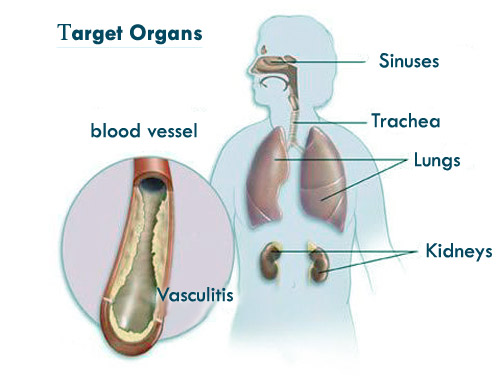Granuloma, Granulomatous

Published: 18 Jun 2025
ICD9: 686.1 ICD10: L92.9 ICD11: 4A00.0Y
"Granuloma" and "Granulomatous" refer to a specific type of inflammation.
Here's a breakdown:
![]() Granuloma: A granuloma is a small, nodular (lumpy) collection of immune cells. It's essentially a wall of inflammatory cells that the body builds to try and contain a substance it can't eliminate. Think of it like a tiny fortress around a foreign invader.
Granuloma: A granuloma is a small, nodular (lumpy) collection of immune cells. It's essentially a wall of inflammatory cells that the body builds to try and contain a substance it can't eliminate. Think of it like a tiny fortress around a foreign invader.
![]() Granulomatous: "Granulomatous" is an adjective that means "characterized by granulomas" or "related to granulomas." For example, "granulomatous inflammation" means inflammation that involves the formation of granulomas.
Granulomatous: "Granulomatous" is an adjective that means "characterized by granulomas" or "related to granulomas." For example, "granulomatous inflammation" means inflammation that involves the formation of granulomas.
Key Components and Characteristics of a Granuloma:
![]() Macrophages: These are the main cells in a granuloma. They are a type of white blood cell that engulfs and digests foreign materials.
Macrophages: These are the main cells in a granuloma. They are a type of white blood cell that engulfs and digests foreign materials.
![]() Epithelioid cells: Macrophages can transform into larger, flattened cells called epithelioid cells. These cells are often a prominent feature of granulomas.
Epithelioid cells: Macrophages can transform into larger, flattened cells called epithelioid cells. These cells are often a prominent feature of granulomas.
![]() Giant cells: Sometimes, several macrophages fuse together to form a giant cell. These cells can have multiple nuclei and are often found in granulomas.
Giant cells: Sometimes, several macrophages fuse together to form a giant cell. These cells can have multiple nuclei and are often found in granulomas.
![]() Lymphocytes: These are another type of white blood cell that can be present in granulomas.
Lymphocytes: These are another type of white blood cell that can be present in granulomas.
![]() Fibroblasts: In some cases, fibroblasts (cells that produce collagen) may also be present, leading to fibrosis (scarring) around the granuloma.
Fibroblasts: In some cases, fibroblasts (cells that produce collagen) may also be present, leading to fibrosis (scarring) around the granuloma.
![]() Necrosis: Some granulomas have a central area of necrosis (tissue death). This is often referred to as "caseous necrosis" when it has a cheese-like appearance, a characteristic feature of tuberculosis.
Necrosis: Some granulomas have a central area of necrosis (tissue death). This is often referred to as "caseous necrosis" when it has a cheese-like appearance, a characteristic feature of tuberculosis.
Causes of Granulomas:
Granulomas form in response to a variety of triggers, including:
![]() Infections:
Infections:![]()

![]() Bacterial: Tuberculosis (TB), leprosy, syphilis
Bacterial: Tuberculosis (TB), leprosy, syphilis![]()

![]() Fungal: Histoplasmosis, blastomycosis, coccidioidomycosis
Fungal: Histoplasmosis, blastomycosis, coccidioidomycosis![]()

![]() Parasitic: Schistosomiasis
Parasitic: Schistosomiasis
![]() Foreign substances:
Foreign substances:![]()

![]() Sutures, talc, splinters
Sutures, talc, splinters
![]() Autoimmune disorders:
Autoimmune disorders:![]()

![]() Sarcoidosis, Crohn's disease, Granulomatosis with Polyangiitis (Wegener's)
Sarcoidosis, Crohn's disease, Granulomatosis with Polyangiitis (Wegener's)
![]() Unknown causes:
Unknown causes:![]()

![]() Some granulomas form for reasons that are not yet fully understood.
Some granulomas form for reasons that are not yet fully understood.
Clinical Significance:
Granulomas can affect virtually any organ in the body, leading to a wide range of symptoms depending on the location and size of the granulomas. They are important because:
![]() They indicate a specific type of inflammatory process. Identifying granulomas helps narrow down the possible causes of a disease.
They indicate a specific type of inflammatory process. Identifying granulomas helps narrow down the possible causes of a disease.
![]() They can cause organ damage. If granulomas are large or numerous, they can disrupt normal tissue function.
They can cause organ damage. If granulomas are large or numerous, they can disrupt normal tissue function.
![]() They may be a sign of a serious underlying condition. It's important to determine the cause of granulomas so that appropriate treatment can be initiated.
They may be a sign of a serious underlying condition. It's important to determine the cause of granulomas so that appropriate treatment can be initiated.
Diagnosis:
Granulomas are usually diagnosed by:
![]() Biopsy: A small sample of tissue is taken and examined under a microscope.
Biopsy: A small sample of tissue is taken and examined under a microscope.
![]() Imaging studies: X-rays, CT scans, and MRI scans can help identify granulomas in certain organs.
Imaging studies: X-rays, CT scans, and MRI scans can help identify granulomas in certain organs.
![]() Laboratory tests: Blood tests and other laboratory tests can help identify the underlying cause of the granulomas.
Laboratory tests: Blood tests and other laboratory tests can help identify the underlying cause of the granulomas.
Treatment:
Treatment depends on the underlying cause of the granulomas. Options may include:
![]() Antibiotics: For bacterial infections like TB.
Antibiotics: For bacterial infections like TB.
![]() Antifungal medications: For fungal infections.
Antifungal medications: For fungal infections.
![]() Corticosteroids: To reduce inflammation.
Corticosteroids: To reduce inflammation.
![]() Immunosuppressants: For autoimmune disorders.
Immunosuppressants: For autoimmune disorders.
![]() Surgery: In some cases, surgery may be necessary to remove granulomas that are causing significant problems.
Surgery: In some cases, surgery may be necessary to remove granulomas that are causing significant problems.
In summary: A granuloma is a specific type of inflammation characterized by a collection of immune cells, usually formed in response to a persistent irritant or infection that the body is trying to contain. Identifying granulomas is important for diagnosis and treatment of a variety of conditions.